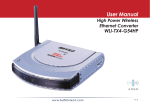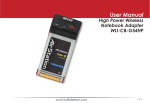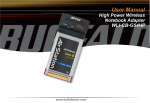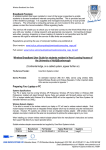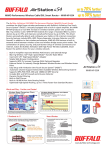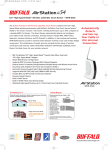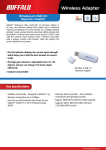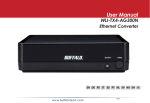Download Buffalo WLI-TX4-G54HP Setup guide
Transcript
Quick Setup Guide High Power Wireless Ethernet Converter WLI-TX4-G54HP This guide is intended to help you quickly and easily install your High Power Wireless Ethernet Converter. For more setup and configuration details, refer to the User Manual located on the Ethernet Converter Utility CD-ROM. Package Contents: • Wireless Ethernet Converter • Ethernet Converter Utility CD-ROM • AC Adapter • Antenna • Base for Vertical Mounting • AC Adapter • Quick Setup Guide www.buffalotech.com v1.8 Basic Setup System Requirements • Desktop or Notebook computer with an RJ-45 Ethernet port (for configuration) • Web Browser (Firefox 1.0 or later, Mozilla 5.0 or later, or IE 5.0 or later) • 802.11b or 802.11g access point (Infrastructure Mode) OR a different computer with an 802.11b or 802.11g wireless adapter (Ad-hoc Mode). Getting Started Screw the antenna into the top or side of your Wireless Ethernet Converter as shown. You may also attach the optional stand if you wish. For best performance, orient the antenna to point straight up. If you want to substitute a different 2.4GHz antenna, make sure that it has the correct RP-SMA connector. Plug the AC adapter into an AC power source and plug the connector into the back of the Ethernet Converter. It will take about 30 seconds to boot up. AOSS Installation If your Wireless Router/Access Point supports AOSS, then AOSS can configure your wireless network for you. To use AOSS to connect your Ethernet converter to your wireless network: • Confirm that the Wireless Router/Access Point and the Ethernet Converter are both powered on. • Hold down the AOSS button on the Wireless Router/Access Point for 3 seconds. • Hold down the AOSS button on the Ethernet converter for 3 seconds. AOSS will take about a minute to configure your wireless network. When finished, the AOSS LEDs on both the Wireless Router/Access Point and the Ethernet Converter will stop blinking and stay lit. You now have a secure connection! AOSS button NOTES: If AOSS is used, then any non-AOSS wireless client devices in your network will have to be manually re-configured to connect to the Router/Access Point in AOSS mode; please consult your Router/Access Point documentation for more information on adding non-AOSS devices. AOSS configures your SSID, encryption type, wireless channel, and encryption key, and makes a secure connection between your wireless components. You may need to run your router's configuration utility to configure your internet connection before using AOSS. If AOSS does not finish properly, power cycle both the Router/Access Point and the Ethernet Converter and attempt the AOSS process again. AOSS works best when the router and the Ethernet Converter are physically close. You can always move them further apart when configuration is complete. Manual Configuration If your wireless router/access point doesn't support AOSS, you'll need to configure the access point manually. There are two ways to do this: you can use the Ethernet Converter Manager software if you have a Windows PC on the network (98/ME/2000/XP only), or you may use a web browser. Web browser configuration may be done with any computer running a recent web browser, including Macintosh and Linux machines (Skip to page 7 for web based config). Ethernet Converter Manager If you have a Windows 98/ME/2000/XP machine with a CD-ROM drive available on your computer network, the Ethernet Converter Manager makes it simple to configure the Ethernet Converter. The following steps will guide you through configuring the Ethernet Converter via the Ethernet Converter Manager. • Connect one of the Ethernet Converter's LAN ports to an open port on your network's router, switch or hub with the included network patch cable. If there are no ports available, you can temporarily remove a computer or other connected device and plug the Ethernet Converter to that port. You can plug the Ethernet Converter directly to the configuring computer, but will have to configure settings manually as described on page 8. • Once the network cable has been plugged in, plug the Ethernet Converter's AC Adapter into an available power outlet. Then attach the power connector to the back of the Ethernet Converter. The boot up process takes 30 seconds and is complete when both the Wireless and Ethernet LEDs are lit. • Return to the PC designated for configuration and insert the included Ethernet Converter CD-ROM into the PC's CD-ROM drive. • The Ethernet Converter Utility should launch automatically. If it does not, browse your CD-ROM drive in Windows and run the setup.exe program. Configuration with Ethernet Converter Manager Click on Ethernet Converter Manager. The Ethernet Converter Manager software will run. If the search doesn't begin automatically, select the Search for an Ethernet Converter option from the Edit drop down menu. The Ethernet Converter Manager will search for all Buffalo Ethernet Converters on your network. The process usually takes less than one minute. Once completed, the Search Results window will appear. Search Results will list all Buffalo Ethernet Converters on the network. If there is more than one Ethernet Converter in the list, select the one you would like to configure. Press the IP Settings button to continue configuration. The IP Address Setup window will open. Check the box next to Use DHCP and press the OK button. The Ethernet Converter will reboot; this process may take as long as a minute. The Ethernet Converter Manager will then re-scan the network for Ethernet Converters. NOTE: If you want to give your Ethernet Converter a static IP address, than you can skip checking Use DHCP and enter your own IP address and Subnet mask in the cooresponding fields. If using a static IP address, it is recommended to pick one inside your existing network's subnet. Search Results will appear again. If more than one Ethernet Converter is present, select the proper Ethernet Converter from the list. Then press the Configure button. The Ethernet Converter Manager will connect you to the Ethernet Converter's web based configuration tool. You will be prompted for a username and password. By default, the username is root and there is no password. After entering the user name, press the OK button. Turn to page 8 to continue configuration. Configuration without Software You may also enter the Web-based Configuration Tool without using the software. This may be necessary to configure the converter without the use of a Windows PC. Use this method with Linux, Macintosh, other other non-Windows PCs to access the Web-based Configuration Tool. Refer to your operating system documentation on how to configure a Static IP address. The Ethernet Converter has an IP address of 1.1.1.1 by default. You'll need to configure the computer to be on the same subnet; an IP address of 1.1.1.2 is recommended for the computer. With the included network patch cable, plug the Ethernet Converter's LAN port into an open port on your network's router, or on one of your network switches or hubs. If there are no ports available, you can temporarily remove a computer or other connected device and plug the Ethernet Converter to that port. You can plug the Ethernet Converter directly to the configuring computer. Once the network cable has been plugged in, plug the Ethernet Converter's AC Adapter into an available power outlet. Then attach the power connector to the back of the Ethernet Converter. The boot up process takes less than a minute and is completed when both the Wireless and Ethernet lights are lit. Once your computer has a Static IP address of 1.1.1.2, open your web browser and access the web page 1.1.1.1 by typing it into the address field (as shown below) and pressing enter. You will be prompted for a username and password. By default, the username is root and there is no password. Press the OK button. Web-based Configuration should open. Web Based Configuration Welcome to Web-based Configuration, where changes to the Ethernet Converter's configuration are made. In Web Based Configuration, you can change the wireless network the Ethernet Converter is associated with, the IP address of the Ethernet Converter, and other important settings. After logging in on the previous pages, you will be greeted by the main configuration page. This page quickly shows you what network the Ethernet Converter is connected to as well as allowing you to search for available networks. The first step in the Web Based Configuration should be to search for an available wireless network. To do this, press the Search button in the SSID (Network Name) table. NOTE: If the wireless network you are attempting to connect to is not broadcasting its SSID, you will need to manually enter the SSID into the SSID field. After it has been manually entered, press the Apply Settings button. Press Search to scan for local access points that are broadcasting their SSID. Select the wireless network that you would like to connect to and press the Select button. Finally, press Set on the main settings page to apply your settings. After selecting a wireless network to connect to, you will be returned to the main Web Based Configuration page. The SSID field will be filled in now. To communicate with your access point, the Encryption Mode must be set to use the same type of encryption as the rest of your network. You will also need to enter the Encryption Key (password) of your network in the space to the right of the encryption mode dropbox. Click Apply Settings when fields are filled in correctly. Note: The SSID, Encryption Mode, and Encryption Key settings for the Ethernet Converter must be configured identically to those of your Access Point. Please consult your Router/Access Point's wireless settings and documentation for further information. Congratulations! Your Ethernet Converter is set up. For information on Advanced Settings, please see the User Manual located on the Ethernet Converter Utility CD-ROM. You may also download the latest version of the manual from www.buffalotech.com. To begin using your Ethernet Converter immediately, disconnect the Ethernet Converter from the network and power adapter, and move it to the desired location. Connect the Ethernet Converter's LAN ports to up to four wired Ethernet devices such as computers, XBoxes, PS2s, or Home Theatre Media Adapters. Plug the AC Adapter into a nearby power outlet and connect the power connector to the Ethernet Converter. Power cycle any devices that are connected to the Ethernet Converter. If you set a static IP address on your computer on page 7, then reference the operating system documentation to restore the IP settings on the computer to obtain an IP Address automatically. For additional settings and features, please see the Ethernet Converter Manual located on the Ethernet Converter Utility CD-ROM. 10 Technical Support Buffalo Technology customers can obtain technical support using the following information: • Online Help: Available on the Ethernet Converter CD enclosed with your purchase. • User Manual: Available on the Ethernet Converter CD enclosed with your purchase. • Web: www.buffalotech.com North America Support is available 24 hours a day, 7 days a week Telephone: 866-752-6210 Email: [email protected] Europe Support is available between 9am-6pm (GMT) Monday-Thursday and 9am-4:30pm on Fridays. Email: [email protected] The constantly evolving state of wireless products and operating systems requires Buffalo Technology to occasionally release updated software to take advantage of new technologies and to comply with industry standards. For the most recent software, firmware, driver, and technical whitepaper releases available, please visit the Buffalo Technology website. FCC Compliance Statement – This device complies with Part 15 of the FCC Rules. Operation is subject to the following two conditions: (1) This device may not cause harmful interference, and (2) this device must accept any interference received, including interference that may cause undesired operation. R&TTE Compliance Statement – This equipment complies with all the requirements of the DIRECTIVE 1999/5/EC OF THE EUROPEAN PARLIAMENT AND THE COUNCIL of 9 March 1999 on radio equipment and telecommunication terminal equipment and the mutual recognition of their conformity (R&TTE). See the user manual for the complete statement. * 54 Mbps is the IEEE 802.11g standard theoretical maximum data transfer rate. Actual wireless network throughput is limited by environmental and system factors and will be less. Copyright © 2005 Buffalo Technology, Inc. All Rights Reserved. Buffalo Technology (USA) Inc., is part of Buffalo Inc. (JAPAN), the global manufacturers of IT peripherals, including memory, networking, and multimedia products, inside many of the world's computers. All trademarks are property of their respective owners. 11 Warranty 6''"-0 &$)/0-0(: 130%6$5s $0.& 8*5) " 580:&"3 -*.*5&% 8"33"/5: '30. 5)& %"5& 0' 163$)"4& 6''"-0 &$)/0-0(: 8"33"/54 50 5)& 03*(*/"- 163$)"4&3 5)& 130%6$5 (00% 01&3"5*/( $0/%*5*0/ '03 5)& 8"33"/5: 1&3*0% )*4 8"33"/5: %0&4 /05 */$-6%& /0/6''"-0 &$)/0-0(: */45"--&% $0.10/&/54 ' 5)& 6''"-0 130%6$5 ."-'6/$5*0/4 %63*/( 5)& 8"33"/5: 1&3*0% 6''"-0 &$)/0-0(: 8*-- "5 their %*4$3&5*0/ 3&1"*3 03 3&1-"$& 5)& 130%6$5 "5 /0 $)"3(& 1307*%&% 5)& 130%6$5 )"4 /05 #&&/ 46#+&$5&% 50 .*464& "#64& 03 /0/6''"-0 &$)/0-0(: "65)03*;&% "-5&3"5*0/s .0%*'*$"5*0/4 03 3&1"*3s )&/ 3&563/*/( " 130%6$5 */$-6%& :063 03*(*/"- 1300' 0' 163$)"4& &563/ 3&26&454 $"//05 #& 130$&44&% 8*5)065 1300' 0' 163$)"4& )*1.&/5 0' 3&563/&% 130%6$ts 50 6''"-0 &$)/0-0(: *4 5)& 3&410/4*#*-*5: 0' 5)& 163$)"4&3 -- &913&44&% "/% *.1-*&% 8"33"/5*&4 '03 5)& 6''"-0 &$)/0-0(: 130%6$5 -*/& "3& -*.*5&% */ %63"5*0/ 50 5)& a#07& 1&3*0% /%&3 /0 $*3$6.45"/$&4 4)"-- 6''"-0 &$)/0-0(: #& -*"#-& */ "/: 8": 50 5)& 64&3 '03 %"."(&4 */$-6%*/( "/: -045 130'*54 -045 4"7*/(4 03 05)&3 */$*%&/5"- 03 $0/4& 26&/5*"- %"."(&4 "3*4*/( 065 0' 5)& 64& 0' 03 */"#*-*5: 50 64& 5)& 6''"-0 130%6$54 6''"-0 &$)/0-0(: 3&4&37&4 5)& 3*()5 50 3&7*4& 03 61%"5& *54 130%6$54 40'58"3& 03 %0$6.&/5"5*0/ 8*5)065 0#-*("5*0/ 50 /05*': "/: */%*7*%6"- 03 &/5*5: # !# ! # # # " # ! # # # # " " -&"4& )"7& :063 300' 0' 63$)"4& 8)&/ $"--*/g B6''"-0 &$)/*$"- 611035 " ""! & 6''"-0 &$)/0-0(: /$ &45 3",&3 "/& 6*5& 645*/ ! &-1 */& &- &."*- )&-1#6''"-05&$)$0. &# )551888#6''"-05&$)$0.8*3&-&44 12 http://www.buffalotech.com USA/Canada Technical Support is available 24 hours a day, 7 days a week Toll-Free: 866-752-6210 email: [email protected] Europe Technical Support is available between 9am-6pm (Monday-Thursday) (GMT) and 9am-4:30pm on Fridays. email: [email protected] ©2005, Buffalo Technology (USA), Inc.













